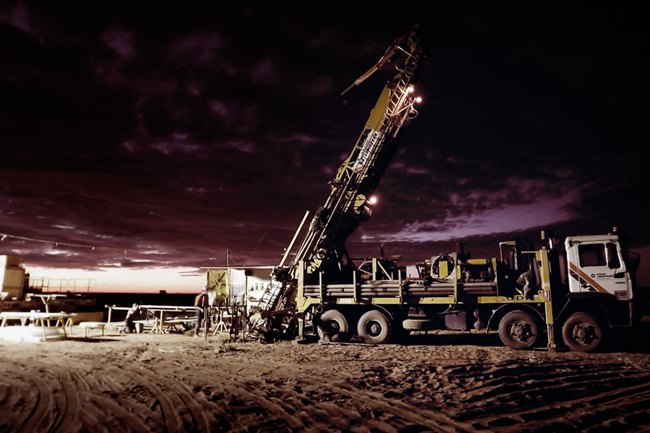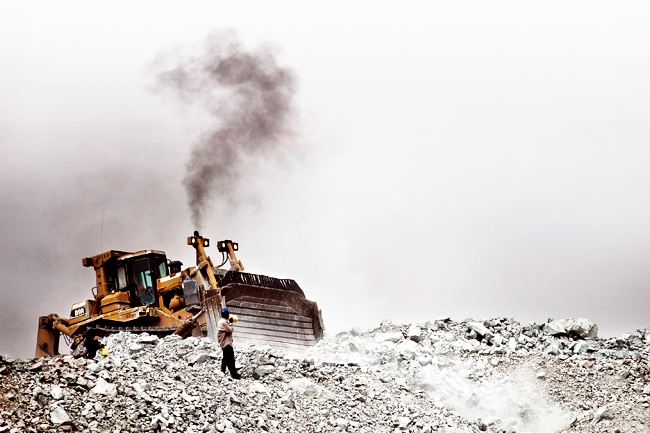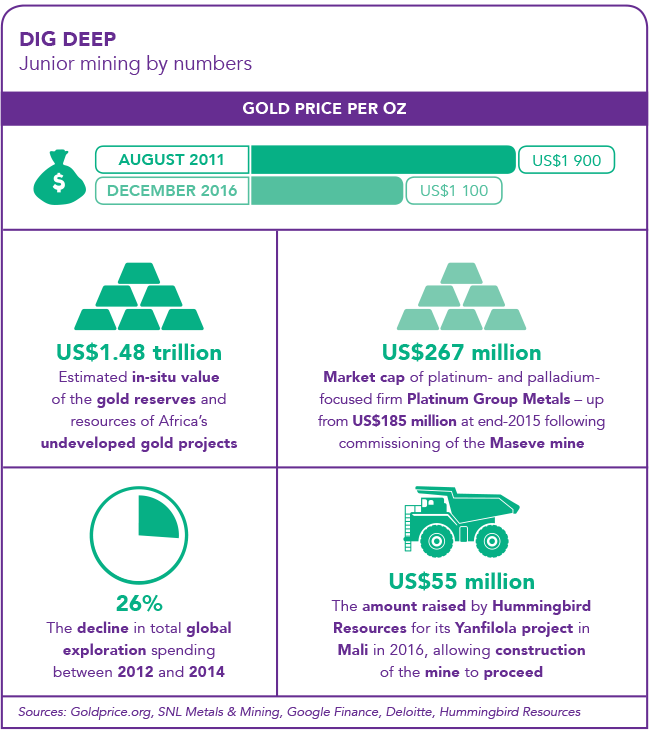Six years ago, the juniors were everywhere. The gold price was way up, to more than US$1 900 per ounce in 2011, and other commodities were booming too – iron ore, phosphates, copper, rare earths and just about everything else. Driven by investors seeking higher returns in riskier jurisdictions, and by those who saw gold as a store of value, money flowed into Africa’s junior explorers and developers.
Fast-forward to the present and the picture has changed completely. The tide of investment has receded – away from minerals and African states – and, in general, only the bigger fish are still swimming.
The ending of the last commodities boom left junior projects around the world stricken, and Africa-focused juniors have perhaps been hardest hit. But small-cap exploration and development is an irrepressible part of the industry, and across the continent some juniors are still doing well.
During the last boom, there were times when it appeared the junior mining sector was gripped by a kind of madness – a modern-day Dutch tulip bubble. Low returns on investment in North America and Europe, and the development of gold miner-backed exchange-traded funds – among other factors – led to an increased interest in African gold exploration. So too with other minerals, such as iron ore, which was driven by Chinese demand.
New Africa-focused junior explorers were constantly springing up, hungry for financing, and the newsfeeds of the Toronto Stock Exchange, Australian Stock Exchange and Alternative Investment Market were filled with various prospectuses and resource announcements – anything to catch investor attention.
Some companies clearly lacked expertise, and some may never have intended to develop their licences. There were explorers posting buoyant announcements from conflict zones, or wildly optimistic inferred resource estimates after a minimal drilling programme. There were also many solid prospects, given the continent’s exceptional undeveloped mineral wealth – but even these have faced a constant struggle to find financing.
In the past few years, the number of active juniors has declined, both across Africa and worldwide. As Mineweb has reported, several one-time junior mining firms have recently moved into the medical marijuana business. For those that remain, the difficulties persist.
At the Junior Indaba in South Africa last year in June, as reported by CNBC, the sector was described by speakers as being ‘moribund’ and ‘on life support’, following a lack of available financing and low interest from governments.
In countries such as South Africa, the junior sector is concerned about the effects of regulatory and tax reforms that started in better times, bringing new mining charters, which often have not been formulated with small companies in mind.
Otsile Matlou, head of mining at law firm ENSafrica, told delegates at the indaba that South Africa’s proposed legislation makes ‘no distinction between someone looking for minerals, and one that has a little mine, or even a major [mine] – currently all are subjected to the same legislation. It’s not designed for mines that will exist 20 years from now, and it’s critical that South Africa looks at the regulation of the industry from a developmental perspective, to understand the key drivers for mines of the future’.
While legislation is an area of concern, the biggest challenges lie in funding junior activity. Analysts at EY have painted a grim picture of the prevailing climate, arguing that access to capital remains a critical challenge for junior miners.
‘The juniors are still subject to widespread investor risk aversion, which is impeding their ability to raise equity. Acquisitions or consolidation to pool resources may be the only realistic growth or exit option for many.
‘For many early-stage companies, the only available scenario is to halt exploration, lay off staff, close premises and maintain only skeletal operations – a form of corporate-induced coma,’ they state.

for new discoveries is one of the most difficult
However, if the outlook is gloomy, it’s also true that African juniors have lived through similar periods in the past. Exploration and development continues across all major regions, and there’s been much activity recently.
In South Africa, London-listed Ironveld has secured funding of ZAR244 million from the government’s Industrial Development Corporation – part of a total ZAR841 million funding package. The loan financing will go towards developing an iron ore, vanadium and titanium project in the country’s Limpopo province, in tandem with the development of a 15 MW smelter complex.
In Mpumalanga, Galane Gold continues to extend an old mine and develop a new tailings processing operation, having acquired the site in 2015 – it anticipated that production would start in the late 2016. The company also produces some gold from a combination underground and open-pit operation in north-eastern Botswana. In quarterly results published in October 2016, Galane reported producing 6 243 oz for the period, for a positive operating cashflow of US$1.8 million. These figures are small but it’s the direction of travel that is arguably most important for a junior at this point – and South Africa holds great potential for junior redevelopment of its many old mines.
Also in South Africa, Platinum Group Metals offers a good example of the development of a junior into a fully fledged producer. The company acquired its initial project in 2004, on the western limb of the country’s world-leading Bushveld Complex. After 12 years of development, it commissioned the Maseve mine in 2016. Currently in ramp-up phase, the mine has a proven and probable four-element resource – comprising platinum, palladium, rhodium and gold – of around 4 million oz.
In partnership with Japan’s state mining company JOGMEC, Platinum Group Metals is also developing the Waterberg project on the Bushveld Complex, discovered following exploration in 2011. The company’s current market cap is about US$267 million, compared to US$185 million at a comparable time the previous year.
If anything, there is more junior activity taking place elsewhere in Africa – far too much to survey in a brief article. Although more work needs to be done to prove their resource base, Tanzania’s Shanta Gold has recently announced a 409% rise in its indicated gold resource. The announcement brings total inferred and indicated resources to about 205 000 oz – the kind of small project where investors may track their estimates, grades and likely production costs for some time before committing funds.
In West Africa there’s continual activity, particularly in the gold sector. London-listed Hummingbird Resources was able to raise US$55 million in mid-2016 to fund commissioning of its Yanfolila gold project in Mali. Although the company’s market cap declined from GBP68 million in 2011 to GBP28 million in 2016, the new funding is a vote of confidence – perhaps unsurprising given Yanfolila’s good ore grades and the way that reserve estimates have progressed to around 700 000 probable ounces at present.
In Senegal, privately held Toro Gold had similarly good fortune last year, after making a significant gold discovery in the country’s Kédougou region in 2011.
Toro has developed its Mako project to a stage where the government felt confident in issuing a mining licence in August 2016, with estimated reserves of around 1 million oz, and an average ore grade of 2.22 grams per ton.
Further east, in Ghana, one of the biggest junior discoveries was announced in 2015 by Cardinal Resources – a maiden 4 million oz resource in the country’s far north. Recent announcements suggest that the devil may be in the details for Cardinal – it has clearly found a sizeable deposit but will need to develop a processing technique adapted to grade and ore type.
All of these are given as a snapshot of recent junior activity, rather than a survey of the most promising projects. For Africa’s juniors, the key to success lies in geological luck, in their relative expert capacity for exploration and development, and in the ability to attract funding interest. The first two factors have always varied, but these days it’s finance that imposes more of a constraint than ever.
As analysts at Deloitte have argued, this is a time when innovative survival strategies are essential – possibly by partnering with established firms, pooling personnel and information with other juniors, or sharing infrastructure and its related costs. For those who make it, there are major gains to be made.
However, until the economic climate changes, say Deloitte analysts, ’junior miners are fighting for survival, trying to feverishly adapt – like plants in the desert, waiting for the rains to arrive’.









